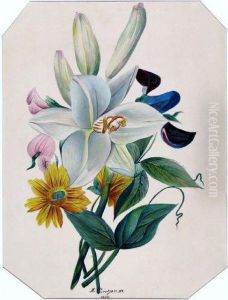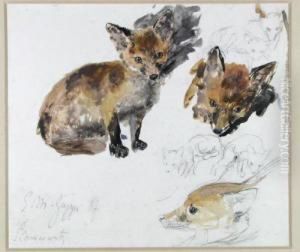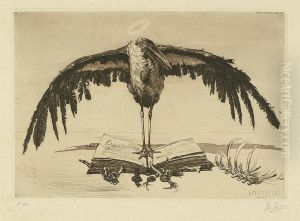Ernst Moritz Geyger Paintings
Ernst Moritz Geyger was a German artist and sculptor known for his versatile body of work, which spanned various artistic disciplines including sculpture, medal-making, and printmaking. Born on May 22, 1861, in Berlin, Germany, Geyger grew up in an environment that was keenly attuned to the arts, which helped foster his early interest in artistic pursuits.
During his formative years, Geyger received a thorough education in the arts. He studied at the Royal Academy of Arts in Berlin, where he honed his skills in sculpture under the tutelage of prominent figures of the time. His education continued in Rome, Italy, a city with a rich artistic heritage that deeply influenced his work. Geyger was particularly drawn to the Renaissance period, and the impact of this era's aesthetic and technical excellence can be seen throughout his career.
Geyger's artistic output was diverse and prolific. He became well-known for his sculptures, which often exhibited a classical style with a focus on the human form, capturing both its physical beauty and emotional expression. His works were characterized by meticulous attention to detail and a deep understanding of anatomy, which allowed him to create pieces that were both realistic and evocative.
Apart from his sculptures, Geyger was also recognized for his contributions to medal-making and printmaking. His medals often commemorated events or individuals and were prized for their exquisite design and craftsmanship. In printmaking, he explored various techniques, producing works that ranged from delicate etchings to bold woodcuts.
Throughout his career, Ernst Moritz Geyger participated in numerous exhibitions and received accolades for his artistic achievements. His works were collected by art connoisseurs and institutions alike, and they continue to be appreciated for their technical mastery and timeless beauty.
Ernst Moritz Geyger's influence extended beyond his own practice as he also dedicated part of his life to teaching, imparting his knowledge and skills to a new generation of artists. He passed away on June 6, 1941, in Baden-Baden, Germany, leaving behind a rich legacy that endures in the world of art history. His works are preserved in various museums and continue to be studied and admired for their contribution to the development of modern sculpture and printmaking.


